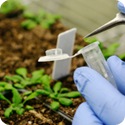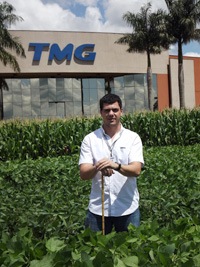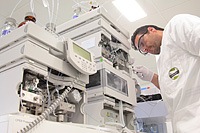Access Agilent eNewsletter, November 2014
>> Update My Profile | Subscribe to Access Agilent | Article Directory

Agilent Bravo Automated Liquid Handling Platform speeds critical agriculture research
Kasia Proctor
Agilent Product Manager Automation Systems
As the world population continues to rise sharply, farmers are challenged to increase yields of crops used for foods and other purposes. Researchers are using the Agilent Bravo Automated Liquid Handling Platform to conduct studies that will help to breed stronger plants and to increase their chances of survival under adverse conditions. This article describes two examples:
- A company in Brazil develops seeds that deliver better yields and greater disease resistance
- An Australian university scientist researches the proteomic basis for plant survival under harsh conditions

Figure 1. Alexandre Garcia leads a team that uses the Bravo Automated Liquid Handling Platform to reduce reaction volumes and associated costs.
“Throughput easily increased tenfold without any major modifications in our lab or personnel.”
Agilent Bravo Platform boosts throughput tenfold, and reduces cost of plant-breeding experiments
Tropical Melhoramento & Genetica, or TMG, is a leading plant-breeding company in Brazil that focuses on two of the country’s biggest crops – soybeans and cotton.
“We deliver to the market seeds that have higher yields and resistance to most of the diseases found here,” says Alexandre Garcia, TMG’s research supervisor (Figure 1).
“A sector of the company is dedicated to the discovery and use of molecular markers in the breeding process,” Garcia says. “Basically, we discover markers linked to phenotypic traits of interest and try to incorporate these markers into our routine screenings. Once a marker is validated, we start to select plants based on the DNA pattern.”
“As a commercial breeding company, we had the need to increase throughput and reduce costs by scaling down our reaction volumes – all without losing the precision,” Garcia says.
He and his team were able to do both with the Agilent Bravo Automated Liquid Handling Platform.
“The system is fast, precise, robust, and very easy to operate. I was impressed with the Bravo from the very first day. We took it out of the box, and in 15 minutes it was already running,” Garcia recalls.
“Prior to installing the Agilent Bravo, we did all the DNA extractions and PCR set-ups by hand. This was a very low-throughput process with a very high chance of errors, especially during transfers from one plate to another.”
“For our applications, throughput easily increased tenfold without any major modifications in our lab or personnel. Plus, the costs of our process decreased because we could reduce all the reaction volumes using the automated pipettors.”
Agilent Bravo Platform accelerates proteomic research on plant survival
Plant-breeding is only one area where the Bravo Platform is useful; plant survival is another. On a spring day in Western Australia’s wheat belt, it can be frosty in the morning and scorching in the afternoon. Even so, farmers are able to grow wheat here. Nicolas Taylor, a research scientist at The University of Western Australia, finds that remarkable (Figure 2).
“During the course of the day, the temperature those plants are exposed to will vary by 35 degrees Celsius, yet they’re able to survive,” Dr. Taylor observes. “Biochemically, that’s a really interesting process.”

Figure 2. Nicolas Taylor uses Agilent instrumentation to identify proteins that change with environmental conditions – so researchers can breed plants that are more adaptable.
“The Agilent Bravo Platform was quite simple to set up and the software is easy to understand.”
Taylor and his colleagues in Perth (and elsewhere) are studying the molecular mechanisms that enable plants to survive harsh conditions of salty soil and extreme temperature variations.
“We’re a proteomics lab, and we’re focused on identifying proteins that change under varying environmental conditions,” Taylor says. “Ultimately what we want to do is understand the ways in which plants adapt to changes in their environment, so that we can breed plants that are more adaptable.”
Fast, accurate, reproducible pipetting
The team does its research using cutting-edge mass spectrometers from Agilent (including two quadrupole time-of-flight and two triple quadrupole systems) and the Agilent Bravo Automated Liquid Handling Platform.
“The Agilent Bravo Platform was quite simple to set up and the software is easy to understand. We were quite quickly able to begin establishing lab-specific protocols. It carries out our application brilliantly. Fast, accurate, reproducible pipetting are the key benefits for us. A robot is of course faster and more accurate at loading plates than any human can be, and our researchers no longer have to spend hours in the cold room loading plates. We now have a great deal more confidence in the results we are obtaining from our analysis. Plus, we have been able to begin planning a number of other applications where it can improve our workflow,” Taylor says.
Compact, fast, and versatile, the Agilent Bravo Platform can accelerate your research as well. To discover more, view our White Paper on flexible automation for application workflows. Then visit our product home page and click the Literature tab to learn how other scientists have taken advantage of the Bravo Automated Liquid Handling Platform to advance their studies.
>> Update My Profile | Subscribe to Access Agilent | Article Directory